General Psychology. Lectures 10 -11 Motivation. 1.
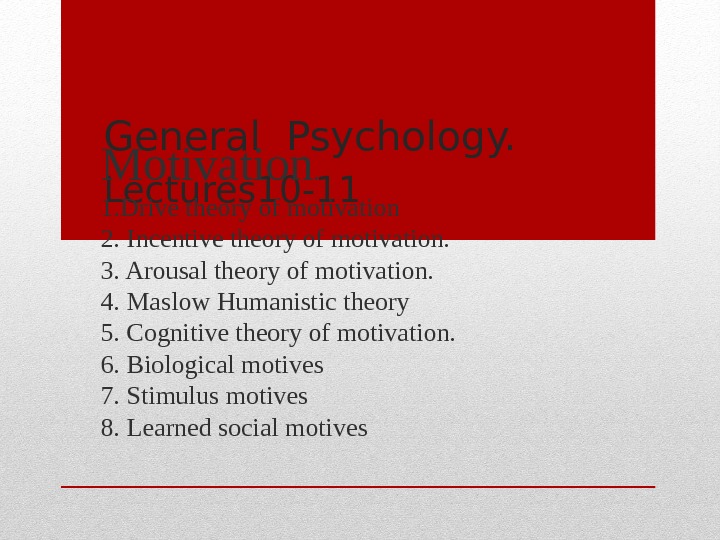
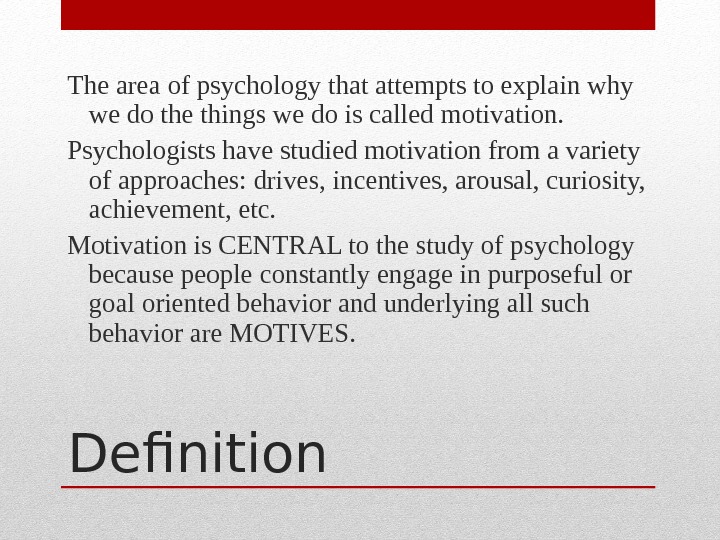

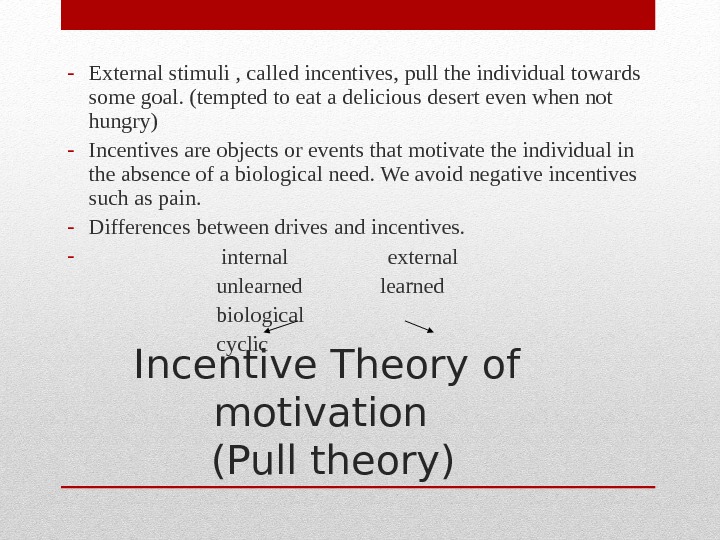
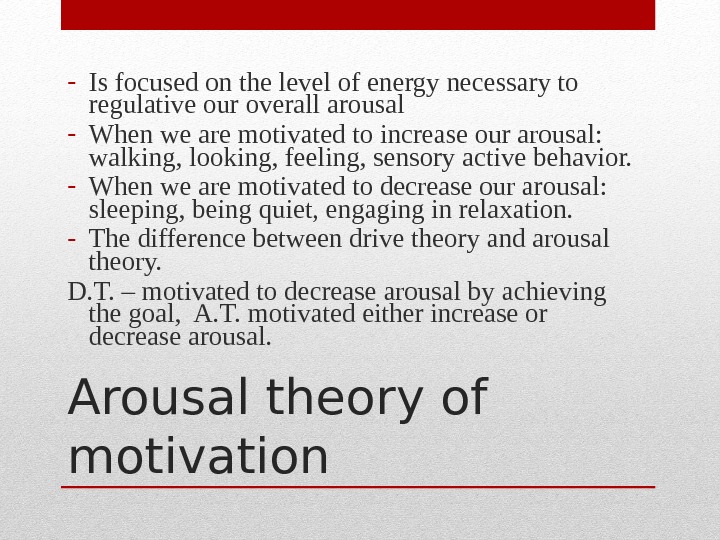

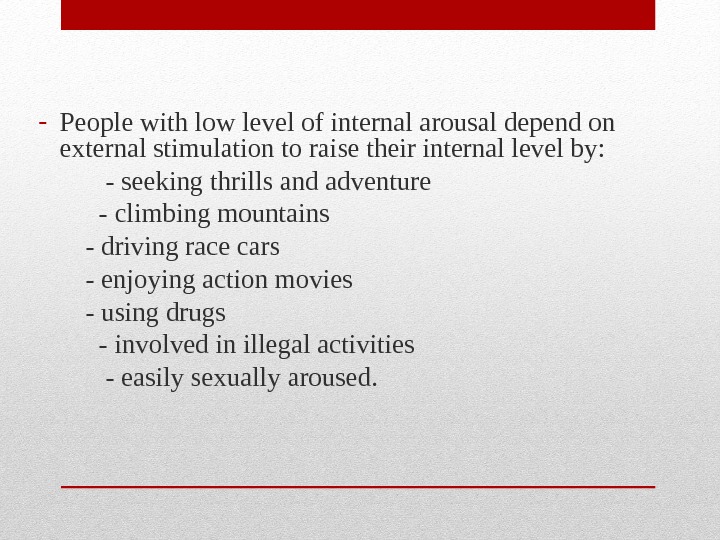
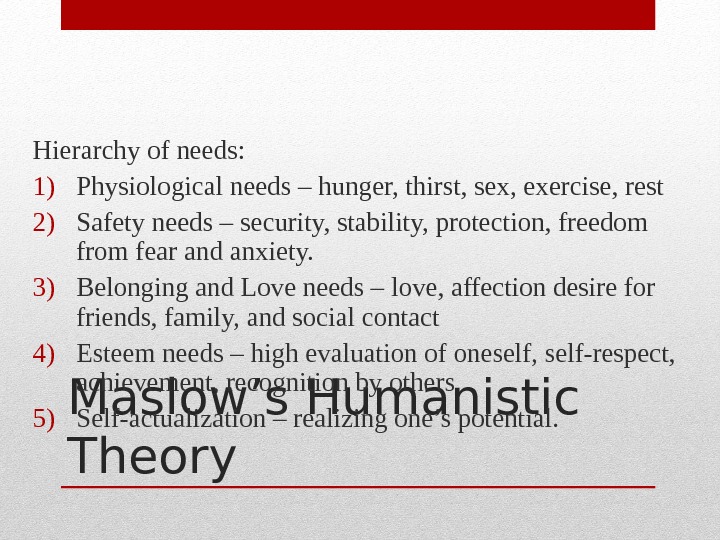
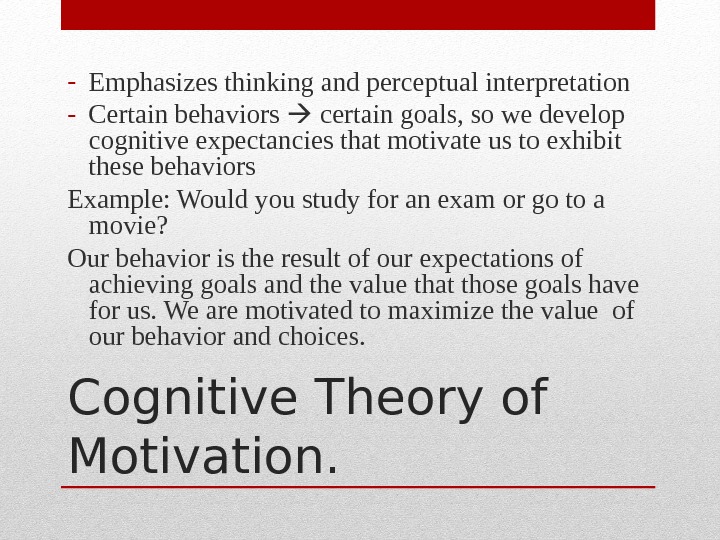

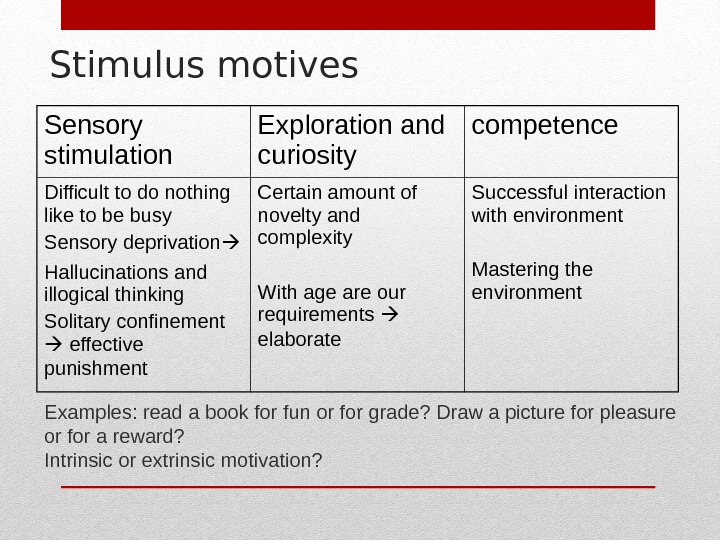
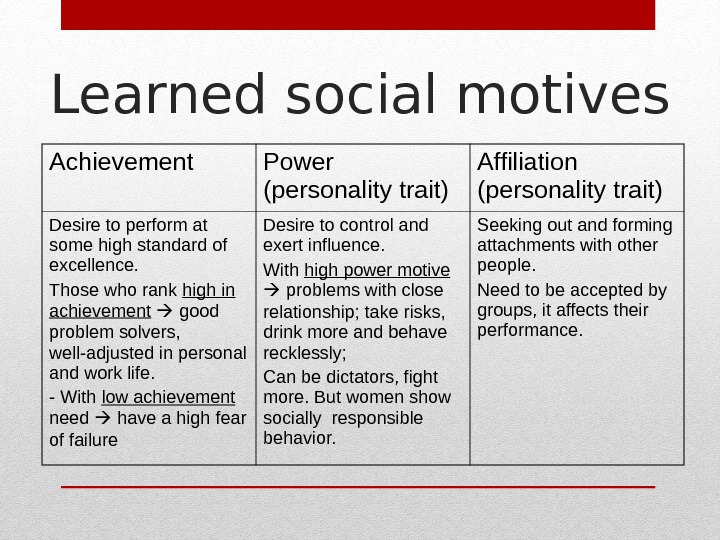
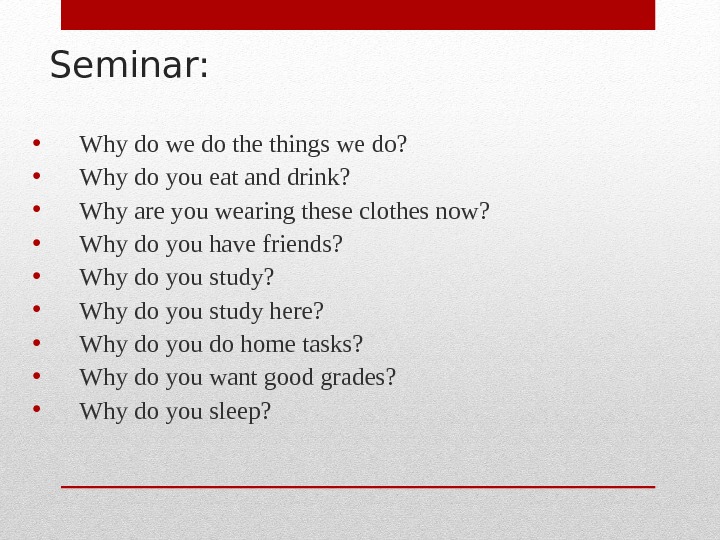
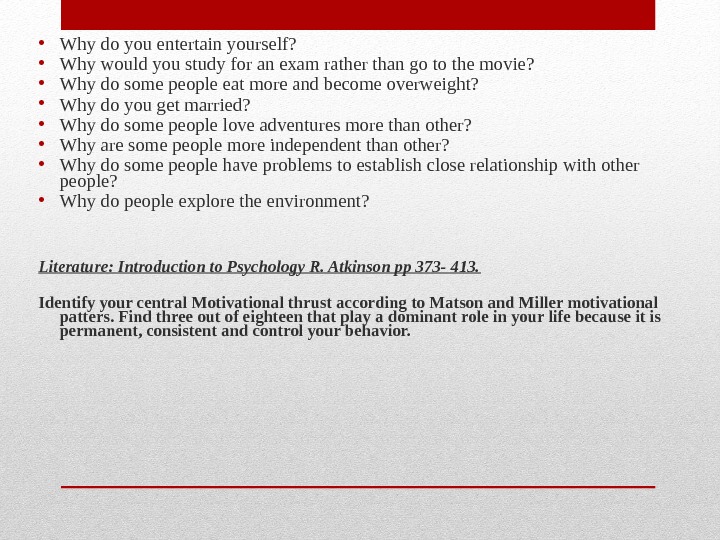
general_psychology_lecture_10-11.ppt
- Размер: 3.7 Mегабайта
- Количество слайдов: 14
Описание презентации General Psychology. Lectures 10 -11 Motivation. 1. по слайдам
 General Psychology. Lectures 10 -11 Motivation. 1. Drive theory of motivation 2. Incentive theory of motivation. 3. Arousal theory of motivation. 4. Maslow Humanistic theory 5. Cognitive theory of motivation. 6. Biological motives 7. Stimulus motives 8. Learned social motives
General Psychology. Lectures 10 -11 Motivation. 1. Drive theory of motivation 2. Incentive theory of motivation. 3. Arousal theory of motivation. 4. Maslow Humanistic theory 5. Cognitive theory of motivation. 6. Biological motives 7. Stimulus motives 8. Learned social motives
 Definition. The area of psychology that attempts to explain why we do the things we do is called motivation. Psychologists have studied motivation from a variety of approaches: drives, incentives, arousal, curiosity, achievement, etc. Motivation is CENTRAL to the study of psychology because people constantly engage in purposeful or goal oriented behavior and underlying all such behavior are MOTIVES.
Definition. The area of psychology that attempts to explain why we do the things we do is called motivation. Psychologists have studied motivation from a variety of approaches: drives, incentives, arousal, curiosity, achievement, etc. Motivation is CENTRAL to the study of psychology because people constantly engage in purposeful or goal oriented behavior and underlying all such behavior are MOTIVES.
 Drive theory of motivation (PUSH theory)- First used by Woodwirth (1918) — Drives are internal forces that push us towards doing smth. (thirst drive drinking, hunger drive eating) — Need Drive Rest goal behavior A need causes a drive, which leads to behavior designed to reach a goal and then allows the individual to rest.
Drive theory of motivation (PUSH theory)- First used by Woodwirth (1918) — Drives are internal forces that push us towards doing smth. (thirst drive drinking, hunger drive eating) — Need Drive Rest goal behavior A need causes a drive, which leads to behavior designed to reach a goal and then allows the individual to rest.
 Incentive Theory of motivation (Pull theory)- External stimuli , called incentives, pull the individual towards some goal. (tempted to eat a delicious desert even when not hungry) — Incentives are objects or events that motivate the individual in the absence of a biological need. We avoid negative incentives such as pain. — Differences between drives and incentives. — internal external unlearned biological cyclic
Incentive Theory of motivation (Pull theory)- External stimuli , called incentives, pull the individual towards some goal. (tempted to eat a delicious desert even when not hungry) — Incentives are objects or events that motivate the individual in the absence of a biological need. We avoid negative incentives such as pain. — Differences between drives and incentives. — internal external unlearned biological cyclic
 Arousal theory of motivation- Is focused on the level of energy necessary to regulative our overall arousal — When we are motivated to increase our arousal: walking, looking, feeling, sensory active behavior. — When we are motivated to decrease our arousal: sleeping, being quiet, engaging in relaxation. — The difference between drive theory and arousal theory. D. T. – motivated to decrease arousal by achieving the goal, A. T. motivated either increase or decrease arousal.
Arousal theory of motivation- Is focused on the level of energy necessary to regulative our overall arousal — When we are motivated to increase our arousal: walking, looking, feeling, sensory active behavior. — When we are motivated to decrease our arousal: sleeping, being quiet, engaging in relaxation. — The difference between drive theory and arousal theory. D. T. – motivated to decrease arousal by achieving the goal, A. T. motivated either increase or decrease arousal.
 Examples for arousal theory: — High arousal anxiety, disorganization, and decreases level of performance. — So, if students are too anxious, they might not do well. — When arousal (motivation) is moderate test performance is best.
Examples for arousal theory: — High arousal anxiety, disorganization, and decreases level of performance. — So, if students are too anxious, they might not do well. — When arousal (motivation) is moderate test performance is best.
 — People with low level of internal arousal depend on external stimulation to raise their internal level by: — seeking thrills and adventure — climbing mountains — driving race cars — enjoying action movies — using drugs — involved in illegal activities — easily sexually aroused.
— People with low level of internal arousal depend on external stimulation to raise their internal level by: — seeking thrills and adventure — climbing mountains — driving race cars — enjoying action movies — using drugs — involved in illegal activities — easily sexually aroused.
 Maslow’s Humanistic Theory. Hierarchy of needs: 1) Physiological needs – hunger, thirst, sex, exercise, rest 2) Safety needs – security, stability, protection, freedom from fear and anxiety. 3) Belonging and Love needs – love, affection desire for friends, family, and social contact 4) Esteem needs – high evaluation of oneself, self-respect, achievement, recognition by others 5) Self-actualization – realizing one’s potential.
Maslow’s Humanistic Theory. Hierarchy of needs: 1) Physiological needs – hunger, thirst, sex, exercise, rest 2) Safety needs – security, stability, protection, freedom from fear and anxiety. 3) Belonging and Love needs – love, affection desire for friends, family, and social contact 4) Esteem needs – high evaluation of oneself, self-respect, achievement, recognition by others 5) Self-actualization – realizing one’s potential.
 Cognitive Theory of Motivation. — Emphasizes thinking and perceptual interpretation — Certain behaviors certain goals, so we develop cognitive expectancies that motivate us to exhibit these behaviors Example: Would you study for an exam or go to a movie? Our behavior is the result of our expectations of achieving goals and the value that those goals have for us. We are motivated to maximize the value of our behavior and choices.
Cognitive Theory of Motivation. — Emphasizes thinking and perceptual interpretation — Certain behaviors certain goals, so we develop cognitive expectancies that motivate us to exhibit these behaviors Example: Would you study for an exam or go to a movie? Our behavior is the result of our expectations of achieving goals and the value that those goals have for us. We are motivated to maximize the value of our behavior and choices.
 Biological motives. — They have a definite psychological basis and biologically necessary for survival of the individual: hunger, thirst, body t regulation, avoidance of pain, sexual drive. Examples: 1) Obese people are much more sensitive to external cues (time, the sight, smell, and taste of food) This conclusion has practical implication for people trying to lose weight. 2) Human sexuality is controlled by the higher brain centers that enables us to learn from experiences, sexual behavior in humans is learned, it is mostly in the head.
Biological motives. — They have a definite psychological basis and biologically necessary for survival of the individual: hunger, thirst, body t regulation, avoidance of pain, sexual drive. Examples: 1) Obese people are much more sensitive to external cues (time, the sight, smell, and taste of food) This conclusion has practical implication for people trying to lose weight. 2) Human sexuality is controlled by the higher brain centers that enables us to learn from experiences, sexual behavior in humans is learned, it is mostly in the head.
 Stimulus motives Sensory stimulation Exploration and curiosity competence Difficult to do nothing like to be busy Sensory deprivation Hallucinations and illogical thinking Solitary confinement effective punishment Certain amount of novelty and complexity With age are our requirements elaborate Successful interaction with environment Mastering the environment Examples: read a book for fun or for grade? Draw a picture for pleasure or for a reward? Intrinsic or extrinsic motivation?
Stimulus motives Sensory stimulation Exploration and curiosity competence Difficult to do nothing like to be busy Sensory deprivation Hallucinations and illogical thinking Solitary confinement effective punishment Certain amount of novelty and complexity With age are our requirements elaborate Successful interaction with environment Mastering the environment Examples: read a book for fun or for grade? Draw a picture for pleasure or for a reward? Intrinsic or extrinsic motivation?
 Learned social motives Achievement Power (personality trait) Affiliation (personality trait) Desire to perform at some high standard of excellence. Those who rank high in achievement good problem solvers, well-adjusted in personal and work life. — With low achievement need have a high fear of failure Desire to control and exert influence. With high power motive problems with close relationship; take risks, drink more and behave recklessly; Can be dictators, fight more. But women show socially responsible behavior. Seeking out and forming attachments with other people. Need to be accepted by groups, it affects their performance.
Learned social motives Achievement Power (personality trait) Affiliation (personality trait) Desire to perform at some high standard of excellence. Those who rank high in achievement good problem solvers, well-adjusted in personal and work life. — With low achievement need have a high fear of failure Desire to control and exert influence. With high power motive problems with close relationship; take risks, drink more and behave recklessly; Can be dictators, fight more. But women show socially responsible behavior. Seeking out and forming attachments with other people. Need to be accepted by groups, it affects their performance.
 Seminar: • Why do we do the things we do? • Why do you eat and drink? • Why are you wearing these clothes now? • Why do you have friends? • Why do you study here? • Why do you do home tasks? • Why do you want good grades? • Why do you sleep?
Seminar: • Why do we do the things we do? • Why do you eat and drink? • Why are you wearing these clothes now? • Why do you have friends? • Why do you study here? • Why do you do home tasks? • Why do you want good grades? • Why do you sleep?
 • Why do you entertain yourself? • Why would you study for an exam rather than go to the movie? • Why do some people eat more and become overweight? • Why do you get married? • Why do some people love adventures more than other? • Why are some people more independent than other? • Why do some people have problems to establish close relationship with other people? • Why do people explore the environment? Literature: Introduction to Psychology R. Atkinson pp 373 — 413. Identify your central Motivational thrust according to Matson and Miller motivational patters. Find three out of eighteen that play a dominant role in your life because it is permanent, consistent and control your behavior.
• Why do you entertain yourself? • Why would you study for an exam rather than go to the movie? • Why do some people eat more and become overweight? • Why do you get married? • Why do some people love adventures more than other? • Why are some people more independent than other? • Why do some people have problems to establish close relationship with other people? • Why do people explore the environment? Literature: Introduction to Psychology R. Atkinson pp 373 — 413. Identify your central Motivational thrust according to Matson and Miller motivational patters. Find three out of eighteen that play a dominant role in your life because it is permanent, consistent and control your behavior.
